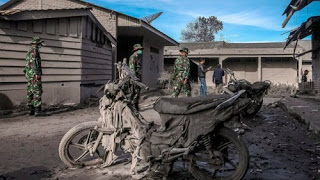Roundup of Global Volcanic Activity
Sinabung (Sumatra, Indonesia): A series of pyroclastic flows occurred yesterday afternoon - sadly, at least one of them was was much larger than most others during the past months and claimed at least 3 victims from local farmers who were working on their fields within the exclusion zone, approx. 4 km from the volcano. The pyroclastic flows - turbulent avalanches of hot debris and ash, caused by partial collapses of the slowly growing lava dome and its over-spilling lava lobes on the upper steep flanks - occurred in a series at 14:28, 15:08 and 16:39 local time. The first of them appears to have been the largest in the series (although clouds obscured views after the first one). The flow reached 4500 m distance (significantly more than any other recent one, compared to averages of 2000-3500 m of similar flows during the past months). Presumably it also was the one that killed the 7 villagers and burnt at least 4 others. All of the victims were caught by surprise (and had no chance of outrunning the flow) while working on their fields within the (unfortunately no longer much enforced) exclusion zone near the former (now officially evacuated) village of Kabanjahean.

Stromboli (Eolian Islands, Italy): The activity at the volcano has picked up recently and is now again at (fluctuating) moderate levels similar to what it has been during much of the past 10-15 years - extremely rewarding for those who climb it in the evening. Apparently, the magma column inside the conduits has again risen and both the eastern, central and western vent are active and produce intermittent strombolian activity of various intensity.
Etna (Sicily, Italy): (22 May) Yet another paroxysm could be under way from the summit craters: after a calm day, strong strombolian eruptions have started a few hours ago from the NE crater. Along with the volcanic tremor signal which is rising again, the activity has been gradually increasing. This might be the beginning of another paroxysm (if strombolian activity from the NE vent is a precursor of more violent activity of the Voragine or even the NE crater - the near future will tell...) Contrary to what it might have looked like, the volcano's activity from last night did not continue to increase, but quieted down for now. Strombolian activity from the Northeast crater seems to have ceased during the second half of the night or early this morning. However, the volcano remains very restless: sporadic ash emissions occurred from the New SE crater and tremor remains slightly elevated, but shows no clear trend right now.
Bagana (Bougainville Island, Papua New Guinea): Mild eruptive activity continues at the volcano. Darwin VAAC reported an ash plume that rose to 7,000 ft (2.1 km) altitude and drifted west yesterday.
Bromo (East Java, Indonesia): Ash emissions from the volcano were reported earlier today by Darwin VAAC. Based on satellite observations, a plume of light ash is drifting 50 km to the NE at approx. 10,000 ft (3 km) altitude.
Dukono (Halmahera): No significant changes have occurred at the volcano. It emits near-constant ash plumes, which are regularly seen on satellite imagery.
Santiaguito (Guatemala): Very elevated activity continues at the active Caliente lava dome. Yesterday, another two strong explosions occurred at 08:30 and around 13:00 local time. Both explosions produced tall ash plumes that rose 3-4 km above the dome, reaching altitudes of 15,000-20,000 ft (4.5 - 6 km) as well as triggering several pyroclastic flows that descended several kilometres on the flanks of the dome. Interestingly, the first explosion at 08:30 was described by CONRED as silent; apparently it did not produce any noise audible in surrounding villages, much unlike almost all previous eruptions. The frequent explosions are beginning serious problems related to ash falls. Determined by the prevailing winds, ash plumes from the explosions again drifted W and SW, causing ash fall in the same areas that have been subject to fallout during much of the previous weeks already: Nuevo Palmar, San Marcos Palajunon, Coatepaque and others.
Fuego (Guatemala): The 10th paroxysmal eruption in 2016 is in progress at the volcano: starting yesterday, explosions have become stronger and more frequent. As the magma output rate increased strongly, the explosions have turned into pulsating lava fountains and a lava flow began to travel down the Las Lajas ravine on the SE flank, currently reaching about 1200-1500 m length. INSIVUMEH reports moderate to strong explosions, glowing avalanches in all directions and noisy rumblings similar to a locomotive train. The FG3 seismic station records strong tremor and rockfall signals. An ash plume is rising to approx. 5000 m elevation and drifting SW and W, where ash fall is occurring in areas such as the volcano observatory in Panimache, Morelia, and El Porvenir villages.
Turrialba (Costa Rica): The eruptive activity of the volcano has remained steady with near-constant ash emissions with occasional increases. According to RSN, the level of seismic activity, dominated by volcanic tremor, gradually increased during Saturday and remained fluctuating yesterday, with an overall stable trend. Bad weather prevented detailed observations during the past 48 hours, but light ash fall is expected in areas downwind (currently west and northwest).
Bristol Island (United Kingdom, South Sandwich Is): The latest eruption likely continues. On recent satellite images, a strong heat source caused by lava is still visible at the summit vent of the remote volcano.
No comments:
Post a Comment